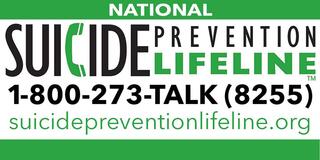
Suicide Awareness
As suicide is the third leading cause of death nationwide among young people ages 10-19 and is the ninth leading cause of death in North Dakota (CDC, 2019), it is critically important that procedures are in place to prevent, assess the risk of, intervene in, and respond to youth suicidal behavior.
Protecting the health and well-being of students is aligned with DPS school policy and is an ethical imperative for all professionals working with youth. Because it is impossible to predict when a crisis will occur, preparedness is necessary for every school. In a typical high school, it is estimated that three students will attempt suicide each year. On average, a young person dies by suicide every two hours in the US. For every young person who dies by suicide, an estimated 100-200 youth make suicide attempts.
Youth suicide is preventable, and educators and schools are key to prevention. As emphasized in the National Strategy on Suicide Prevention, preventing suicide depends on suicide prevention procedures and a holistic approach that promotes healthy lifestyles, families, and communities. Thus, this handbook is intended to be paired with other policies and efforts that support youth's emotional and behavioral well-being. Please refer to the included Resources Section for additional information.
If a person talks about:
- Killing themselves
- Feeling hopeless
- Having no reason to live
- Being a burden to others
- Feeling trapped
- Unbearable pain
Behaviors that may signal risk, especially if related to a painful event, loss, or change:
- Increased use of alcohol or drugs
- Looking for a way to end their lives, such as searching online for methods
- Withdrawing from activities
- Isolating from family and friends
- Sleeping too much or too little
- Visiting or calling people to say goodbye
- Giving away prized possessions
- Aggression
- Fatigue
People who are considering suicide often display one or more of the following moods:
- Depression
- Anxiety
- Loss of interest
- Irritability
- Humiliation/Shame
- Agitation/Anger
- Relief/Sudden Improvement
Source: ASFP.ORG

While there is no single cause for suicide, there are risk factors and warning signs which may increase likelihood of an attempt. Learning them can save lives.
If you are concerned that a friend may be thinking about suicide, you can help!
- Listen to your friend. Do NOT give advice, just listen to what they have to say. Avoid distractions and focus on your friend.
- Ask if they are thinking about suicide.
- If your friend says "yes", take them seriously. Do not leave them alone.
- This cannot be kept a secret. Take your friend to get help.
There are many people you can talk to if you or a friend are ever thinking about suicide!
- Teachers
- Counselors
- School Social Workers
- Administrators
- Coaches
- Paras
- TRUSTED ADULT
- Parents
- Police
- Doctor
- Clergy (Pastor, Priest, Youth Group Leader)
- Therapist
- Extended (adult) family members
- Suicide hotline (1-800-273-8255)
- Suicide Text Line (Text HELP to 271-271)


